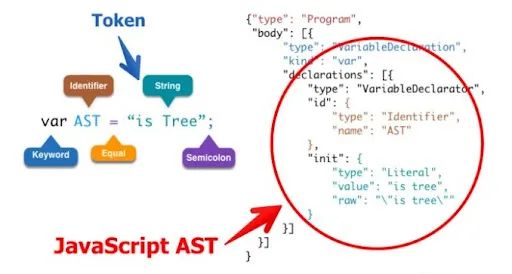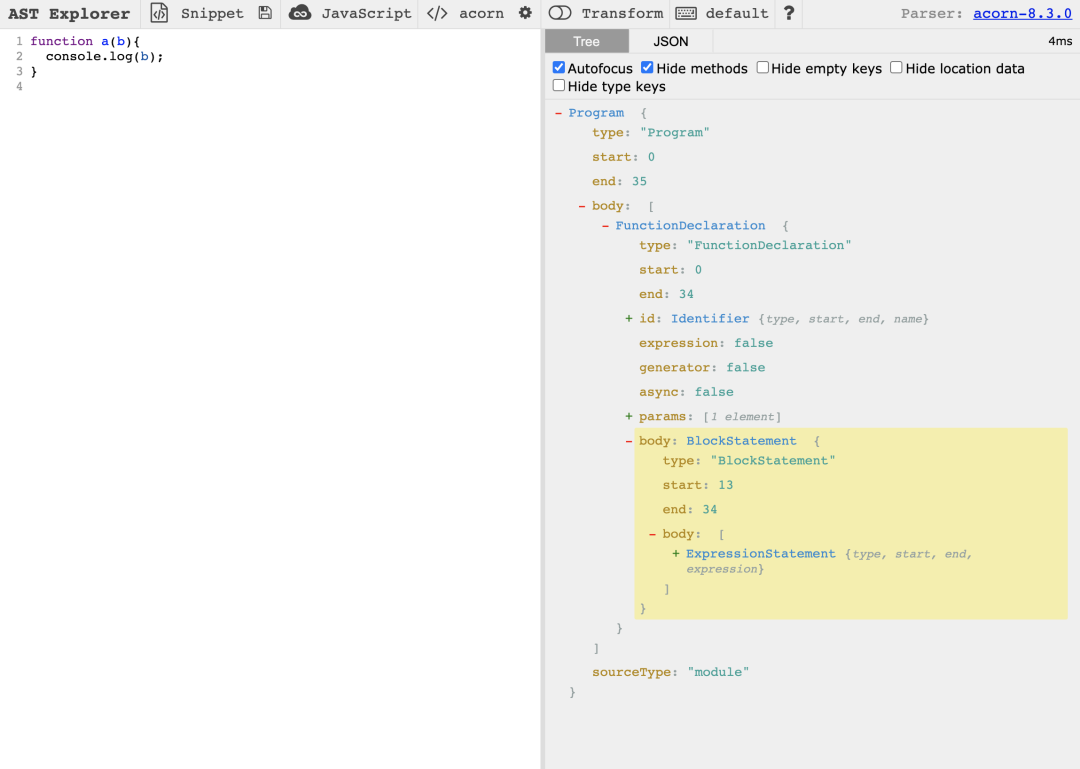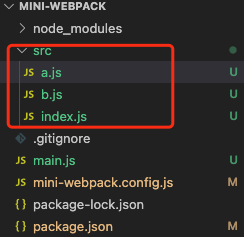手把手教你写一个迷你 Webpack
一、前言
最近正好在学习 Webpack,觉得 Webpack 这种通过构建模块依赖图来打包项目文件的思想很有意思,于是参考了网上的一些文章实现了一个简陋版本的 mini-webpack,通过入口文件将依赖的模块打包在一起,生成一份最终运行的代码。想了解 Webpack 的构建原理还需要补充一些相关的背景知识,下面一起来看看。
二、背景知识
1 . 抽象语法树(AST)
什么是抽象语法树?
平时我们编写程序的时候,会经常在代码中根据需要 import 一些模块,那 Webpack 在构建项目、分析依赖的时候是如何得知我们代码中是否有 import 文件,import 的是什么文件的呢?Webpack 并不是人,无法像我们一样一看到代码语句就明白其含义,所以我们需要将编写的代码转换成 Webpack 认识的格式让他它进行处理,这份转换后生成的东西就是抽象语法树。下面这张图能很好地说明什么是抽象语法树:
可以看到,抽象语法树是源代码的抽象语法结构树状表现形式,我们每条编写的代码语句都可以被解析成一个个的节点,将一整个代码文件解析后就会生成一颗节点树,作为程序代码的抽象表示。通过抽象语法树,我们可以做以下事情:
- IDE 的错误提示、代码格式化、代码高亮、代码自动补全等
- JSLint、JSHint、ESLint 对代码错误或风格的检查等
- Webpack、rollup 进行代码打包等
- Babel 转换 ES6 到 ES5 语法
- 注入代码统计单元测试覆盖率
想看看你的代码会生成怎样的抽象语法树吗?这里有一个工具 能够在线预览你的代码生成的抽象语法树,感兴趣的不妨上去试一试。
2 . Babel
Babel 是一个工具链,主要用于将采用 ECMAScript 2015+ 语法编写的代码转换为向后兼容的 JavaScript 语法,以便能够运行在当前和旧版本的浏览器或其他环境中。通过 Babel 我们可以做以下事情:
- 语法转换
- 通过 Polyfill 方式在目标环境中添加缺失的特性(通过第三方 Polyfill 模块,例如core-js,实现)
- 源码转换 (codemods)
一般来说项目使用 Webpack 来打包文件都会配置 babel-loader 将 ES6 的代码转换成 ES5 的格式以兼容浏览器,这个过程就需要将我们的代码转换成抽象语法树后再进行转换处理,转换完成后再将抽象语法树还原成代码。
// Babel 输入:ES2015 箭头函数
[1, 2, 3].map((n) => n + 1);
// Babel 输出:ES5 语法实现的同等功能
[1, 2, 3].map(function(n) {
return n + 1;
});3 . Webpack 打包原理
Webpack 的构建过程一般会分为以下几步:
- 读取 Webpack 基础配置
// 读取 webpack.config.js 配置文件:
const path = require("path")
module.exports = {
entry:"./src/index.js"
mode:"development"
output:{
path:path.resolve(__dirname,"./dist"),
filename:"bundle.js"
}
}-
入口文件分析
-
分析依赖模块
-
分析内容
-
编译内容
-
依赖模块分析
-
分析依赖模块是否有其他模块
-
分析内容
-
编译内容
-
生成打包文件
// 基础结构为一个IIFE自执行函数
// 接收一个对象参数,key 为入口文件的目录,value为一个执行入口文件里面代码的函数
(function (modules) {
// installedModules 用来存放缓存
const installedModules = {};
// __webpack_require__用来转化入口文件里面的代码
function __webpack_require__(moduleIid) { ... }
// IIFE将 modules 中的 key 传递给 __webpack_require__ 函数并返回。
return __webpack_require__(__webpack_require__.s = './src/index.js');
}({
'./src/index.js': (function (module, exports) {
eval('console.log(\'test webpack entry\')');
}),
}));三、具体实现
1 . 安装相关依赖
我们需要用到以下几个包:
- @babel/parser:用于将输入代码解析成抽象语法树(AST)
- @babel/traverse:用于对输入的抽象语法树(AST)进行遍历
- @babel/core:babel 的核心模块,进行代码的转换
- @babel/preset-env:可根据配置的目标浏览器或者运行环境来自动将 ES2015 + 的代码转换为 es5
使用 npm 命令安装一下:
npm install @babel/parser @babel/traverse @babel/core @babel/preset-env -D
2 . 读取基本配置
要读取 Webpack 的基本配置,首先我们得有一个全局的配置文件:
// mini-webpack.config.js
const path = require('path');
module.exports ={
entry: "./src/index.js",
mode: "development",
output: {
path: path.resolve(__dirname,"./dist"),
filename: "bundle.js"
}
}然后我们新建一个类,用于实现分析编译等函数,并在构造函数中初始化配置信息:
const options = require('./mini-webpack.config');
class MiniWebpack{
constructor(options){
this.options = options;
}
// ...
}3 . 代码转换,获取模块信息
我们使用 fs 读取文件内容,使用 parser 将模块代码转换成抽象语法树,再使用 traverse 遍历抽象语法树,针对其中的 ImportDeclaration 节点保存模块的依赖信息,最终使用 babel.transformFromAst 方法将抽象语法树还原成 ES5 风格的代码。
parse = filename => {
// 读取文件
const fileBuffer = fs.readFileSync(filename, 'utf-8');
// 转换成抽象语法树
const ast = parser.parse(fileBuffer, { sourceType: 'module' });
const dependencies = {};
// 遍历抽象语法树
traverse(ast, {
// 处理ImportDeclaration节点
ImportDeclaration({node}){
const dirname = path.dirname(filename);
const newDirname = './' + path.join(dirname, node.source.value).replace('\\', '/');
dependencies[node.source.value] = newDirname;
}
})
// 将抽象语法树转换成代码
const { code } = babel.transformFromAst(ast, null, {
presets:['@babel/preset-env']
});
return {
filename,
dependencies,
code
}
}4 . 分析依赖关系
从入口文件开始,循环解析每个文件与其依赖文件的信息,最终生成以文件名为 key,以包含依赖关系与编译后模块代码的对象为 value 的依赖图谱对象并返回。
analyse = entry => {
// 解析入口文件
const entryModule = this.parse(entry);
const graphArray = [entryModule];
// 循环解析模块,保存信息
for(let i=0;i<graphArray.length;++i){
const { dependencies } = graphArray[i];
Object.keys(dependencies).forEach(filename => {
graphArray.push(this.parse(dependencies[filename]));
})
}
const graph = {};
// 生成依赖图谱对象
graphArray.forEach(({filename, dependencies, code})=>{
graph[filename] = {
dependencies,
code
};
})
return graph;
}5 . 生成打包代码
生成依赖图谱对象,作为参数传入一个自执行函数当中。可以看到,自执行函数中有个 require 函数,它的作用是通过调用 eval 执行模块代码来获取模块内部 export 出来的值。最终我们返回打包的代码。
generate = (graph, entry) => {
return `
(function(graph){
function require(filename){
function localRequire(relativePath){
return require(graph[filename].dependencies[relativePath]);
}
const exports = {};
(function(require, exports, code){
eval(code);
})(localRequire, exports, graph[filename].code)
return exports;
}
require('${entry}');
})(${graph})
`
}6 . 输出最终文件
通过获取 this.options 中的 output 信息,将打包代码输出到对应文件中。
fileOutput = (output, code) => {
const { path: dirPath, filename } = output;
const outputPath = path.join(dirPath, filename);
// 如果没有文件夹的话,生成文件夹
if(!fs.existsSync(dirPath)){
fs.mkdirSync(dirPath)
}
// 写入文件中
fs.writeFileSync(outputPath, code, 'utf-8');
}7 . 模拟 run 函数
我们将上面的流程集成到一个 run 函数中,通过调用该函数来将整个构建打包流程跑通。
run = () => {
const { entry, output } = this.options;
const graph = this.analyse(entry);
// stringify依赖图谱对象,防止在模板字符串中调用toString()返回[object Object]
const graphStr = JSON.stringify(graph);
const code = this.generate(graphStr, entry);
this.fileOutput(output, code);
}8 . mini-webpack 大功告成
通过上面的流程,我们的 mini-webpack 已经完成了。我们将文件保存为 main.js,新建一个 MiniWebpack 对象并执行它的 run 函数:
// main.js
const options = require('./mini-webpack.config');
class MiniWebpack{
constructor(options){
// ...
}
parse = filename => {
// ...
}
analyse = entry => {
// ...
}
generate = (graph, entry) => {
// ...
}
fileOutput = (output, code) => {
// ...
}
run = () => {
// ...
}
}
const miniWebpack = new MiniWebpack(options);
miniWebpack.run();四、实际演示
我们来实际试验一下,看看这个 mini-webpack 能不能正常运行。
1 . 新建测试文件
首先在根目录下创建 src 文件夹,新建 a.js、b.js、index.js 三个文件
三个文件内容如下:
-
a.js
export default 1;
-
b.js
export default function(){
console.log('I am b');
}-
index.js
import a from './a.js';
import b from './b.js';
console.log(a);
console.log(b);2 . 填入配置文件
配置好入口文件、输出文件等信息:
const path = require('path');
module.exports ={
entry: "./src/index.js",
mode: "development",
output: {
path: path.resolve(__dirname,"./dist"),
filename: "bundle.js"
}
}3 . 完善 package.json
我们在 package.json 的 scripts 中新增一个 build 命令,内容为执行 main.js:
{
"name": "mini-webpack",
"version": "1.0.0",
"description": "",
"main": "index.js",
"scripts": {
"test": "echo \"Error: no test specified\" && exit 1",
"build": "node main.js"
},
"author": "",
"license": "ISC",
"devDependencies": {
"@babel/core": "^7.15.4",
"@babel/parser": "^7.15.4",
"@babel/preset-env": "^7.15.4",
"@babel/traverse": "^7.15.4"
}
}4 . 效果演示
我们执行 npm run build 命令,可以看到在根目录下生成了 dist 文件夹,里面有个 bundle.js 文件,内容正是我们输出的打包代码:
执行下 bundle.js 文件,看看会有什么输出:
可以看到,bundle.js 的输出正是 index.js 文件中两个 console.log 输出的值,说明我们的代码转换没有问题,到这里试验算是成功了。
五、项目 Git 地址
项目代码在此:mini-webpack
六、参考文章
- 实现一个简单的 Webpack
2 . Babel 中文文档
3 . 【你应该了解的】抽象语法树 AST
4 . webpack 构建原理和实现简单 webpack




